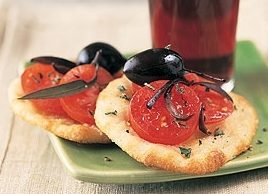Double-Cheese Pizza Bites
What a delicious way to welcome your guests! These mini double-cheese pizza bites are loaded with fresh tomato slices, black olives and fresh herbs. And because they’re on the light side, everyone will still have room for dinner.
Source: Cook Smart for a Healthy Heart, Reader’s Digest Canada

| Servings | Prep Time | Cook Time | Passive Time |
| 48pizza bites | 40minutes | 20minutes | 10minutes rising |
| Servings | Prep Time |
| 48pizza bites | 40minutes |
| Cook Time | Passive Time |
| 20minutes | 10minutes rising |
- 3 1/4 cups all-purpose flour plus extra for sprinkling
- 1 tsp sugar
- 1/2 tsp salt
- 1 envelope dried yeast about 8 g
- 1 cup tepid water
- 1 tbsp extra virgin olive oil
- 2 cups cherry tomatoes thinly sliced
- 1 cup reduced-fat mozzarella cheese grated
- 4 tbsp Parmesan cheese freshly grated
- 12 kalamata olives pitted and cut into slivers, to sprinkle
- 1/4 cup fresh oregano leaves to sprinkle
|
Ingredients
Servings: pizza bites
Units:
|
- Place the flour in a large bowl and stir in the sugar, salt and yeast. Make a well in the centre and pour in the tepid water and oil. Gradually mix the flour into the water and oil; use a wooden spoon, then your hand, to make a soft dough.
- Turn the dough onto a floured surface and knead for about 10 minutes, until smooth and elastic. Sprinkle the surface with a little extra flour if necessary, but try not to add too much as this will make the dough dry. Shape into a ball, cover with a clean dish towel and leave to rise for 10 minutes.
- Preheat the oven to 450ºF (230°C). Line two baking sheets with parchment paper. Divide the dough into 4 pieces. Wrap 3 pieces in plastic wrap and refrigerate. Cut the remaining piece into 12 equal pieces and shape each into a 4 cm ball. Arrange on the baking sheets and flatten into 7 cm rounds. Lightly coat with nonstick cooking spray.
- Top each with 2–3 tomato slices, 1 teaspoon mozzarella cheese and a little Parmesan cheese. Sprinkle with a few olive slivers and oregano leaves. Bake until the crust is golden-brown and crisp and the cheese is melted and bubbly, about 10 minutes. Repeat to use up the remaining dough. Serve double-cheese pizza bites hot.
Per pizza: 40 calories, 2 g protein, 1 g total fat, 0.4 g saturated fat, 2 mg cholesterol, 6 g total carbohydrate, 1 g sugars, 0.4 g fibre, 55 mg sodium
Olives contain healthy monounsaturated fat, which tends to lower LDL (the “bad”) cholesterol, thus helping to prevent the formation of artery-clogging plaque, which increases the risk of heart disease.




